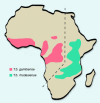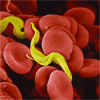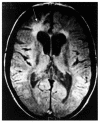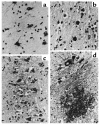Human African trypanosomiasis of the CNS: current issues and challenges
- PMID: 14966556
- PMCID: PMC338269
- DOI: 10.1172/JCI21052
Human African trypanosomiasis of the CNS: current issues and challenges
Abstract
Human African trypanosomiasis (HAT), also known as sleeping sickness, is a major cause of mortality and morbidity in sub-Saharan Africa. Current therapy with melarsoprol for CNS HAT has unacceptable side-effects with an overall mortality of 5%. This review discusses the issues of diagnosis and staging of CNS disease, its neuropathogenesis, and the possibility of new therapies for treating late-stage disease.
Figures






References
-
- Vickerman, K. 1997. Landmarks in trypanosome research. In Trypanosomiasis and leishmaniasis. G. Hide, J.C. Mottram, G.H. Coombs, and P.H. Holmes, editors. Cab International. Oxford, United Kingdom. 1–37.
-
- Williams, B.I. 1996. African trypanosomiasis. In The Wellcome Trust illustrated history of tropical diseases. F.E.A.G. Cox, editor. The Wellcome Trust. London, United Kingdom. 178–191.
-
- Bentivoglio M, Grassi-Zucconi G, Kristensson K. From trypanosomes to the nervous system, from molecules to behavior: a survey, on the occasion of the 90th anniversary of Castellani’s discovery of the parasites in sleeping sickness. Ital. J. Neurol. Sci. 1994;15:77–89. - PubMed
-
- 1986. Epidemiology and control of African trypanosomiasis. Report of a WHO expert committee. World Health Organization. Geneva, Switzerland. Technical Report Series, No. 739. 126 pp. - PubMed
-
- Atouguia, J.L.M., and Kennedy, P.G.E. 2000. Neurological aspects of human African trypanosomiasis. In Infectious diseases of the nervous system. L.E. Davis and P.G.E. Kennedy, editors. Butterworth-Heinemann. Oxford, United Kingdom. 321–372.

